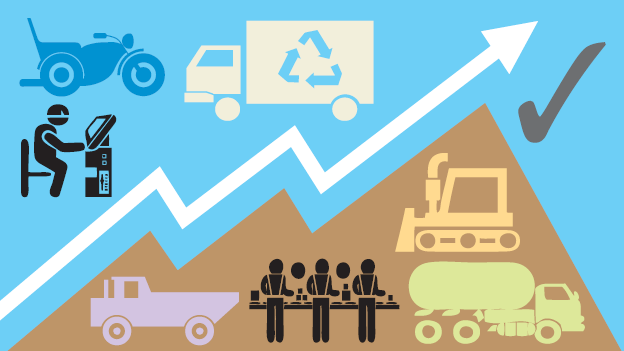Resource Efficiency Experiences in India: Construction and Automotive Sector

© GIZ, Resource Efficiency India
This study is a central part of the project titled Resource Efficiency and Sustainable Management of Secondary Raw Materials (in short “Resource Efficiency”). The German Federal Ministry for the Environment, Nature Conservation, Building and Nuclear Safety (BMUB), under its International Climate Initiative, has launched the project as a bilateral cooperation project with the Indian Ministry of Environment, Forest and Climate Change (MoEF&CC).
The project is being implemented by GIZ-India, in cooperation with German and Indian knowledge partners, as well as with external experts. The project aims to enable key Indian institutions responsible for the formulation of environment, climate, industry, and resource policy to aid and establish institutional frameworks that improve resource efficiency.
Main features and components
The project has three interrelated action plans (work packages):
- First, material flows in key selected sectors of the Indian economy will be mapped to identify gaps, barriers, and areas of intervention.
- Second, options for improving resource efficiency and enhancing the use of secondary raw materials will be demonstrated on a pilot basis for selected industry sectors.
- Third, a high-level Indian Resource Panel (InRP) will be set up with renowned experts who will provide recommendations to the Government of India based on the learnings from the project.
This study is part of the first action plan (work package 1). A detailed analysis of material flows, resource needs, utilisation and trends in selected sectors – automotive and construction – will help to achieve a better understanding of these sectors and identify gaps and barriers for resource efficiency and potential areas of intervention. These findings will inform both the selection of pilot demonstration projects as well as the deliberations of the Indian Resource Panel.
Implementation and work steps
For the two sectors that are the focus of this study, five “priority” materials were identified based on their importance to the resource efficiency debate in India. For each identified material, the flows into/out of the economy (e.g., imports and exports), domestic extraction, as well as flows within the economy (for different sectors and applications, waste recycling, etc.) were analysed.
Five important materials used in the automotive sector were: iron and steel, copper, aluminium, zinc and nickel, plastics and composites. Five materials in the construction sector were: sand, soil, stone (aggregates), limestone, and iron and steel.
Lessons learnt
The lessons coming out from the analysis of the two sectors in this report can be extended and applied to the wider economy as well. This is the broader goal of the Indian Resource Panel set up under the project. A comprehensive resource policy would need to:
- Involve a wide range of stakeholders, starting from coordination between different government ministries such as mining, transportation, heavy industry, etc., as well as between different levels of government including state and local, to research and standard setting organisations, to the private sector, and finally civil society.
- Encompass the entire life cycle of resources – from extraction, to transportation, processing, manufacturing, use, disposal as well as recycling/reuse.
- Emphasise education, awareness, outreach and capacity development at all levels – government, the private sector and civil society – with a special focus on green marketing.
Output
- Automobile manufacturing and use can be made more sustainable with the help of new technologies such as: bio-fuels, electric engines, hydrogen fuels and low weight materials, and use of secondary raw materials and integrating resource efficiency in the production process of different types of vehicles and components.
- The adoption of measures to improve resource efficiency and reduce energy consumption will lead to reduced GHG emissions in the automobile sector.
- The use of construction and demolition waste will help resource conservation and mitigation of CO2 emissions from processing of natural stones into aggregates.
Recommendations for the automotive sector:
- Greater recovery of secondary materials from end-of-life vehicles
- Improved material flow management
- Increased product life
- Improved design to incorporate sustainable materials
- Importance of training and capacity development
- Reducing air pollution and GHG emissions
- Developing a broader perspective on mobility
Recommendations for the construction sector:
- Accurate inventorisation of C&D waste
- Building capacities of urban local bodies
- Technical support to new entrepreneurs
- Building a business case for private entrepreneurs
- Large-scale awareness and sensitisation of users
- Developing favourable policies for products made from secondary materials
Downloads
Characteristics
Phase of intervention
Operating SIA, Resource efficiency
Level of intervention
Policy level (central)
Regions
Asia
Countries
India
Target groups
Policy makers